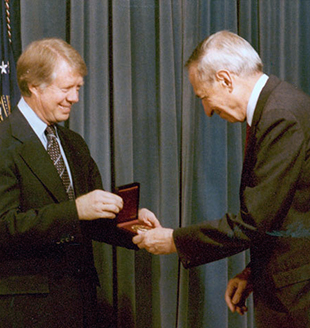

George Uhlenbeck (1900-1988)
National Medal of Science recipient in 1976 “for the major discovery, together with Samuel A. Goudsmit, of the electron spin as a source of a new quantum number.”
George Uhlenbeck was born in what is now Jakarta, to Eugenius Marius Uhlenbeck, who served in the Dutch East Indian Army, and Anne Marie Beeger, the daughter of a Dutch major general. He was one of six children, though two died of malaria when they were young. The family moved to the Netherlands when Uhlenbeck was 6 years old. As a teenager, he was encouraged to pursue science and mathematics by his physics teacher, and earned his bachelor’s degree from Leiden University in 1920. Uhlenbeck worked hard to alleviate the financial strain on his family, taking on extra jobs and commuting a long distance from his parents' house to save living expenses.
While at school, Uhlenbeck sought mentorship from his physics professor, Paul Ehrenfest. Ehrenfest introduced Uhlenbeck to Enrico Fermi, who would become a lifelong friend, and assigned Uhlenbeck to work with another graduate student, Samuel Gouldsmit. Uhlenbeck and Gouldsmit discovered what would be their most significant breakthrough, electron spin. The discovery was deemed momentous by such giants in the field as Niels Bohr, Werner Heisenberg, Wolfgang Pauli and Albert Einstein.
In 1927, Uhlenbeck earned his Ph.D. from Leiden University, married Else Ophorst, and moved to the United States to accept a position at the University of Michigan, as did Gouldsmit. Uhlenbeck became an American citizen, but returned to teach in the Netherlands from time to time throughout his career. He served as president of the American Physical Society in 1959, and was a member of the faculty at Rockefeller University from 1960 until his retirement in 1974.
E.G.D. Cohen, a student of Uhlenbeck, described him as “an inspiring teacher. With superbly organized and extremely clear lectures, he laid bare for everyone to see the beautiful structure of statistical mechanics... he transmitted to a younger generation what he conceived to be the essence of the past and the way to the future. In doing so, he educated several generations of physicists in statistical mechanics in a style rare in this century.”
Image descriptions and credits
Any opinions, findings, conclusions or recommendations presented in this material are only those of the presenter grantee/researcher, author, or
agency employee; and do not necessarily reflect the views of the National Science Foundation.


